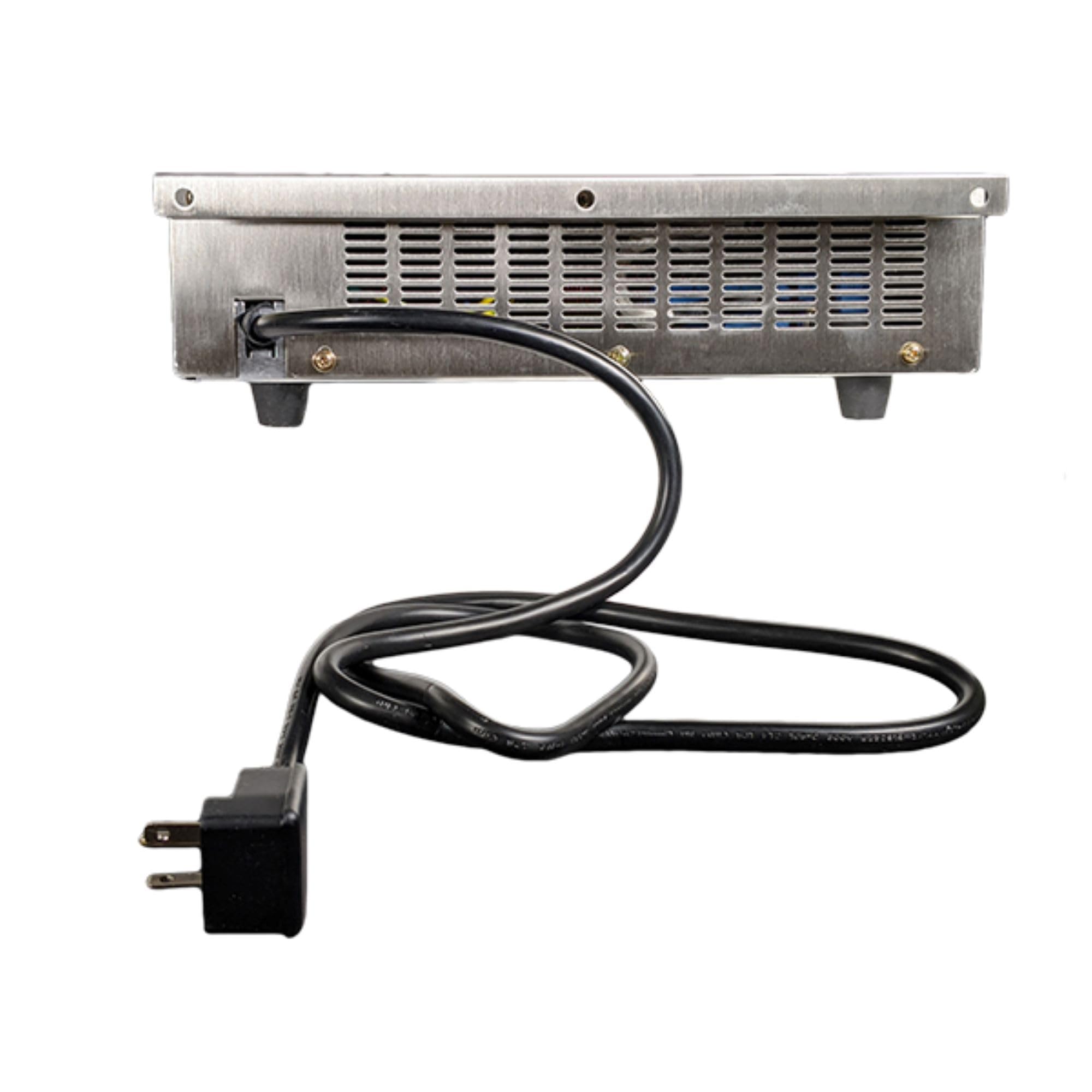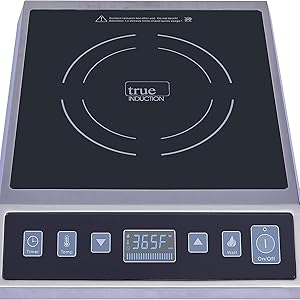Deliver to Sri Lanka
IFor best experience Get the App










Cook Smart, Live Bold! 🍳
The TI-1SS 13 Inch Portable Single Burner Induction Cooktop is a powerful and efficient cooking solution, boasting 3200 watts of power and 90% energy efficiency. Designed for versatility, it features adjustable wattage settings and is compatible with various cookware types. Its compact size makes it ideal for any kitchen, while its UL certification ensures safety and reliability.








R**Y
Good induction
I have one of these burners and works really well.8 Month so far and still working like champ!
S**I
Return back. Got credits quickly. Temperature setting must ...
Return back. Got credits quickly. Temperature setting must be dial type so food/water overflow while reducing temperature it takes more time to reduce temperature or power. Quick setting buttons must be provided to reduced power instantly
D**E
High power, large induction coil but flawed temperature control
This induction cook top is rated at 3200 watts, which is high enough to boil water much faster than a standard electric cook top. My tests show it can boil 3 quarts of 80 degree water from the tap here in Florida in 6 minutes 30 seconds. That's twice as fast as my built-in Jenn-Air electric cook top, which required 13 minutes to achieve a rolling boil for cooking pasta. Note that if your main requirement from an induction cook top is time to boil water then a 120 volt unit will unlikely be much faster than a standard built-in 240 volt electric or natural gas burner. To use this unit you must have a NEMA 6-20R 240 volt 20 amp outlet in your kitchen. If not, one can be installed by an electrician but it's best to research this requirement in advance of ordering any induction cooktop that requires 240 volts in order to know all of the costs involved.This burner uses a pulse or duty cycle method to control average power below the 1600 watt setting. This should not prove to be a problem if your pots and pans have a high thermal mass and high thermal conductivity as mine do. At the lowest setting of 400 watts I had no trouble frying 2 strips of bacon very slowly, without even noticing that induction power was cycling on and off, except for the faint sound of a relay clicking inside the unit. The bacon was fried very uniformly as there were no hot spots that I could measure anywhere in my non-stick frying pan, using a non-contact infrared thermometer. Bumping up the power setting to 600 watts resulted in faster cooking but the result again was very uniform perfectly fried bacon, better tasting bacon than I was ever able to achieve with my electric burner. This test confirms that this induction burner uses a fairly large diameter induction coil that heats the bottom of the pan uniformly.The internal cooling fan noise is noticeable but not objectionable although a bit louder than lower powered 120 volt induction units. The higher power of this commercial burner requires more cooling of its internal electronics than lower powered burners.There is a problem, however, when using the temperature control feature to cook small amounts of foods. When attempting to fry two strips of bacon with the temperature set at the minimum allowed setting of 150 degrees F, my non-stick frying pan became very hot, very quickly, as indicated by an infrared non-contact thermometer. In fact, the bacon was burnt to a crisp before I knew what was happening! This was a puzzle that deserved some serious investigation. What I discovered is that, like other induction cook tops, this one uses a temperature sensor placed in the center but underneath the glass-ceramic cooking surface. Since this material is a very poor conductor of heat, this built-in temperature sensor was totally unaware of my frying pan's actual high temperature. I could verify this by momentary removing my frying pan and measuring the center of the glass-ceramic cooking surface using the same infrared non-contact thermometer. The center of the cooking surface measured only 140 degrees while the inside of my pan measured a searing 400 degrees! And the 140 degree temperature was on the top of the cooking plate. The sensor is mounted on the underside, which would presumably be sensing even less than 140 degrees since glass-ceramic is a very poor heat conductor. The unit's electronics were obviously unaware that my pan was already much hotter than 150 degrees and so they continued to supply high power to the pan, which explains the burnt bacon. This inability to quickly and accurately sense the cookware temperature is also exacerbated by frying pans, like mine, that have a logo and other text embossed on the bottom center area, in this case, an Anolon Nouvelle Copper Stainless Steel 9-1/2-Inch Nonstick Skillet rated to work with induction burners. The embossing on the bottom of this pan reduces the surface area that is in direct contact with the center of the cooking surface. Such embossing is very common and so the problem cannot be blamed on the pan. And I found little improvement by moving the pan off center to afford better contact between the pan and the cooking surface in the center where the temperature sensor is located. What bothered me most was that there was no warning or caution in the manual that this situation could occur so easily. It did warn against not heating empty cookware but two strips of bacon are not uncommon: Even in a restaurant it could happen that only two strips of bacon are required for a recipe.I conclude that using the temperature control mode is worse than useless and very dangerous to non-stick cookware because some non-stick coatings can easily be damaged by the high temperatures created in a few minutes by the high power output of this induction cook top. While the manufacturer claims to have an automatic shutoff at 450 degrees F, this is useless since the pan's temperature is not being sensed directly but only indirectly through a sensor mounted on the underside of the glass-ceramic cooking surface. The pan's non-stick coating could vaporize long before that sensor was aware that the pan's temperature was over 450 degrees F. I would note, however, that almost all other induction cook tops share the same problem -- it's not unique to this particular burner. Until someone does the engineering necessary to quickly and accurately sense the actual temperature of the cookware or its contents, as opposed to the simply sensing the underside of the cooking surface, then I'd avoid using the temperature control mode of any induction cook top. Recall that induction cook tops do not get hot by themselves. The AC magnetic field heats only the cookware while the temperature sensor is mounted on the bottom of the glass-ceramic cooking plate. Given the poor heat conductivity of glass-ceramic materials, it's physically impossible for the sensor to sense fast changes (either up or down) in the temperature of the cookware, even when the cookware and cook top are in intimate contact with each other and that requires a perfectly flat cook top surface as well as a perfectly flat cookware bottom surface. Otherwise, an air gap will form between them in some places and one may easily form over the sensor area in the center. Air is an even worse heat conductor than glass-cermamic further thermally isolating the sensor from the cookware thus creating an even greater overheating hazard. Cookware when new may be nearly perfectly flat but repeated heating and cooling will normally distort the bottom surface slightly. In conclusion, very poor engineering of the temperature control systems of induction cook tops is being tolerated by the whole industry, not just this manufacturer. I understand now why induction cooking has not been embraced by more cooks -- it's the induction cooking industry's own stupidity! It would have been far better not to offer any temperature control option than offering the fatally flawed version seen in this and other common induction cook tops. Indeed, traditional gas and electric burners do not offer a temperature control option and so cooks have gotten used to tweaking their burners' control knobs from time to time while cooking. The temperature control feature offered by induction cook tops gives potential users the false impression that they can just set their desired cooking temperature and walk away. But doing so often results in scorched sauces, burnt bacon and can even ruin non-stick coatings, especially if the food contains little water. This feature could easily result in a grease fire. So, potential converts to induction cooking often conclude it doesn't work and go back to using gas or even electric burners. It does not help that the manual makes no mention of the severe limitations of the built-in temperature control feature. There is no doubt in my mind that the manufacturers of induction cook tops are all well aware of these limitations and potential hazards and yet pretend they don't exist. Again, I'm not singling out this particular model or manufacturer, as they all use the same flawed method of sensing the cookware temperature. This is also not an indictment of induction cooking, which puts heat only where it's required and with great speed. Induction cooking is a great idea that's being held back by a ridiculously stupid method of temperature control.In my view, the only method of using this induction cook top effectively and safely is to dispense with the temperature control entirely and use only the power control feature (from 400 to 3200 watts in 200 watt increments). Changing the power setting of an induction cook top is equivalent to turning the knob on a conventional electric and gas burner. Temperature is best monitored using a non-contact infrared thermometer aimed at the inside of cookware surface or the food itself while cooking in order to avoid overheating since the high power capability of this induction burner can raise cookware temperatures in mere seconds, much faster than gas or electrical resistance burners. That high power, however, is why this induction burner is a time saver when cooking pasta. This model also sports a large diameter induction coil that heats cookware bottoms uniformly thus avoiding hot spots that can scorch delicate sauces and is the reason it fries bacon to near perfection when used with a suitable skillet. When water begins to boil, for example, bubbles form over a fairly large circular area about 7-8 inches in diameter. There is no narrow ring of bubbles as has been reported with some other high power induction units. That's why I decided to give this unit 4 stars even with its fatally flawed temperature control feature. It also has a built-in timer that turns the unit off automatically after the programmed time has elapsed and it's very light in weight given its high power output.
J**N
Damage
I was bought in March for store opening. My store was got shut down for covid-19.When I first time use it, it was broke. And I couldn't even return it.
A**R
True Induction works GOOD!
Good product! I have tried many brand of 220V cooktop, and finally found one that works great and last long life.
S**H
Excellent choice
Excellent and high performing device.. Light in weight and is very portable
A**R
Made in china and it shows
Failed first time after less than 3 hours use will try to get money back
J**Y
Five Stars
very good ,so fast!!!
Trustpilot
1 month ago
1 week ago